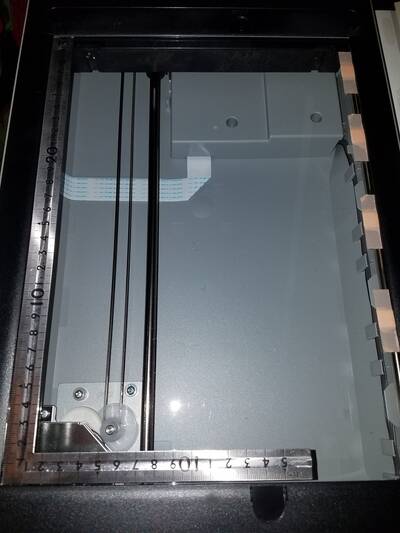Table of Contents
Placing Your Paper
Do not align your paper against the edge of the scanner, doing so will cut off the edges of the scanned content.
Annoyingly nearly all scanners will cut off your scans when you line up against the edges. Because of this we'll need to buffer our scans with a bit of space in order to avoid anything being lost during the scanning process. Scanners tend to have two corners of the actual scanning bed that cut off a lot more than the opposing sides. We can use that space for materials to help straighten our scans as we can consider it lost space anyway, and we want to make sure we have the most space possibly available for scanning while also keeping things as straight as possible.
For example on the Epson V550 the left and bottom sides of the scanner cut off a lot more than the top and right. If you’re using a different model you’ll need to do some test scans to figure out which sides it cuts off more in your case.
Carpenter Squares & Rulers
Rulers and squares are useful because they allow you to have straight scans while also buffering against the edge of the scanner and avoids you having your scans cut off. The important thing with these however are that you only leave them on your scanner while scanning if they are the same or lower thickness than what you're scanning. If they are thicker than what you're scanning, your scanner lid won't close down flat which means your scan will not be flat. This is a big reason we recommend to use a square instead of a ruler, because when scanning something thin it can be easier to lift one square off of the scan bed without disturbing the item, than if trying to do the same with two rulers. One example where the square has been very useful is PlayStation 2 covers as they are MUCH thinner than the square, so it cannot be left on the bed but it's relatively easy to lift it off the glass without disturbing the cover. Ultimately it's up to you to decide what works best for you, you might even become skilled in aligning without any tools.
One recommendation is the SHINWA CARPENTER’S SQUARE 30CM*15CM Model No. 12130. It does require a trim on the 30CM side to fit the flatbed which is kind of tricky as it’s stainless steel. However if you have the tools to do that it’s a great solution as it’s thinness fits against most game boxes very well. But again you don't have to use this exact model and you can use everyday rulers or other squares instead. Below is an image of how the Shinwa square is used on one of our scanners.
Lining up and Flattening
Now place your square/rulers along the corner of your scanner which you know has more dead space, press your flattened boxes/artwork up against its corner to get a straight scan, and lower your scanner lid. Place a heavy book or object on top of the scanner lid to help flatten the item as much as possible and hit Preview on your scanning software. If the scan looks straight go ahead and scan it! If not readjust and preview again until you’re satisfied. Just to be clear it's VERY difficult to get a perfectly straight scan so don't sweat it too much if it's off a tiny bit, just do the best you can and don't drive yourself crazy. If you're using a ruler or square, the odds are you'll have a very straight scan regardless.
Playing cards and index cards
Playing cards and index cards pressed along the sides of the scanner are also an easy option that can help with paper thin materials such as manuals.
Another important point when scanning a manual, remove the staples for a higher quality scan! If you don't remove the staples your scan won't be flat and you'll also run the risk of scratching your scanner glass. Just like with anything else you scan place a heavy book or something heavy on top of the scanner lid once you close it to get the scan as flat as possible, and do a preview before scanning to make sure the manual pages are straight enough. These are notoriously hard to get straight so just do your best.
Dealing with bleed-through is another thing you’ll have to deal with, especially when scanning in white manual pages as they’ll usually show text and artwork from the opposite side. An easy solution to this is to use some black construction paper or poster board and place it on top of the thing you’re scanning. One way to rig it up can be by trimming a sheet of posterboard that fit your scanner plate, and then tape it along the bottom of your scanner lid. Your scanner might looks a little weird with tape on it but it works!
